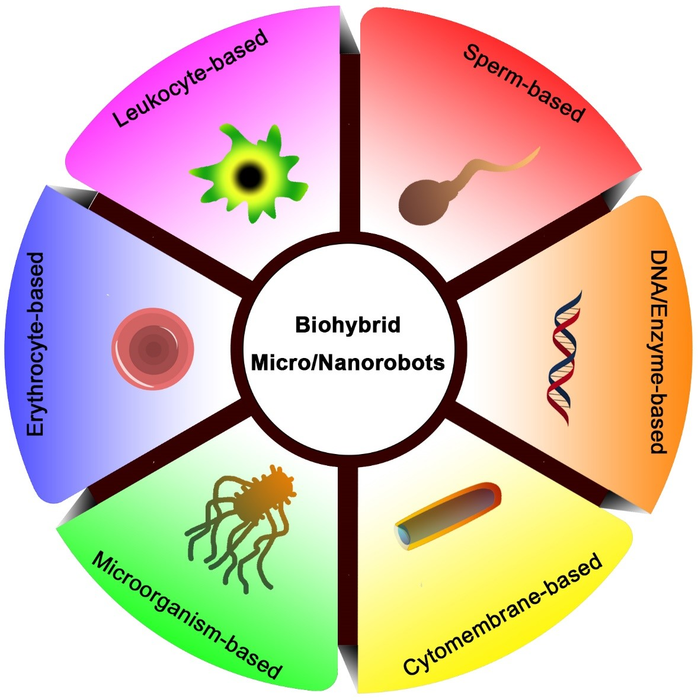A recent study by researchers at the Beijing Institute of Technology encapsulated the latest advancements in the use of smart biohybrid micro- and nanorobots for human medical applications.
 Scientists from the Beijing Institute of Technology reviewed progress and perspectives of biohybrid micro- and nanorobots for intelligent drug delivery. Image Credit: Jinhua Li, Beijing Institute of Technology.
Scientists from the Beijing Institute of Technology reviewed progress and perspectives of biohybrid micro- and nanorobots for intelligent drug delivery. Image Credit: Jinhua Li, Beijing Institute of Technology.
The new study appeared in the February 10th issue of the journal Cyborg and Bionic Systems and has provided an overview of how miniature robots with living components are engineered and fabricated to carry out tasks such as effectively supplying drugs to body tissues.
These biohybrid micro- and nanorobots are being widely investigated in the field of smart drug delivery for precision therapy of cancer and other diseases.
Jinhua Li, Study Author and Professor, Beijing Institute of Technology
The upcoming field of microbotics includes research and development of robots on a micron-size scale for practical applications.
“This emerging research field has received ever-increasing attention, especially after molecular machines were selected as the topic of the Nobel Prize in Chemistry 2016,” said research authors.
The biohybrid microrobots studied by the team have both living biological parts and nonliving parts; usually, an artificial carrier crawls or swims to convey living components to where they conduct tasks in the human body.
Biohybrid micro- and nanorobots hold promise to transform medicine as they can be remotely regulated to carry out a biochemical function with high precision. In addition to cancer treatment, these robots have roles to play in other small-scale operations such as assisted fertilization, microsurgery of cells and tissue engineering.
The application scenarios of biohybrid micro- and nanorobots can be expanded from currently focused cancer treatment to many other research fields.
Jinhua Li, Study Author and Professor, Beijing Institute of Technology
The newly published study examined the potential uses of different biohybrid robots. They range from 1 μm to approximately 20 μm in size, with the difference mostly stemming from their components.
For example, on the small (nano) end, a DNA-based robot can supply the blood-clotting agent thrombin to halt the movement of blood to a cancer tumor cell. On the larger (micro) end, a sperm-based robot can supply the anticoagulant heparin to heal a circulatory system disease.
The authors of the study categorized biohybrid micro- and nanorobots into six functional groups: cytomembrane-based; erythrocyte-based; microorganism-based; leukocyte-based; DNA/enzyme-based; and sperm-based.
Platelet microrobots, for example, are designed with a long circulation time in the bloodstream that enables them to collect and deliver drugs to the targeted tissue. Leukocyte microrobots, designed with immune cells, possess the unique ability to chemotactically steer toward an infection to deliver drugs.
Going forward, the team visualizes integrating unique biological components into biohybrid robots. For example, when a robot is introduced, one hurdle is to surpass the human immune response. If bacteria already in a person’s body was instead controlled to carry out therapeutic operations that could alleviate an immune response as well as the danger of introducing pathogens.
Another challenge is the efficiency of engineering the miniature, nonliving carriers. Future research and development will probably yield unique ways of carrying the biological parts around, such as magnetic fields or light; advancements in methods for manufacturing the nonliving parts; and improved imaging methods such as magnetic particle imaging and MRIs.
Scientists believe biohybrid robots will become even more advanced and specialized for performing complicated medical tasks.
“The research field of biohybrid micro- and nanorobots for drug delivery is still in its infancy,” said Li, explaining that the majority of studies have been conducted in the laboratory with limited studies in humans. Biohybrid robots could be valuable in many facets of medicine, including gene therapy, cell microsurgery, and engineering to replace or repair damaged tissues.
The article calls upon scientists, engineers, medical professionals, and other experts to collaboratively promote the study on biohybrid micro robots into real-world applications in clinical settings.
Authors of the study include Jinhua Li, Lukas Dekanovsky, Bahareh Khezri, Bing Wu, Huaijuan Zhou, and Zdenek Sofer.
The European Structural and Investment Funds, OP RDE-funded project “CHEMFELLS IV”; the Beijing Institute of Technology Teli Young Fellow Program; the Czech Science Foundation; and the European Union’s Horizon 2020 research and innovation program under the Marie Sklodowska-Curie grant agreement.
Journal Reference:
Li, J., et al. (2022) Biohybrid Micro- and Nanorobots for Intelligent Drug Delivery. Cyborg and Bionic Systems. doi.org/10.34133/2022/9824057.